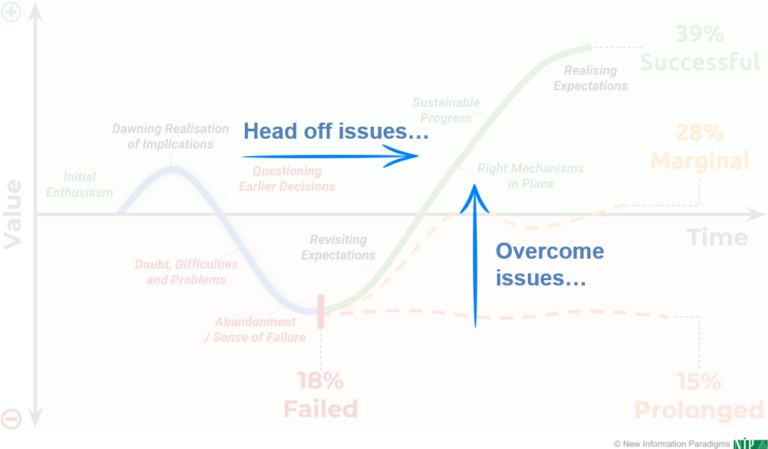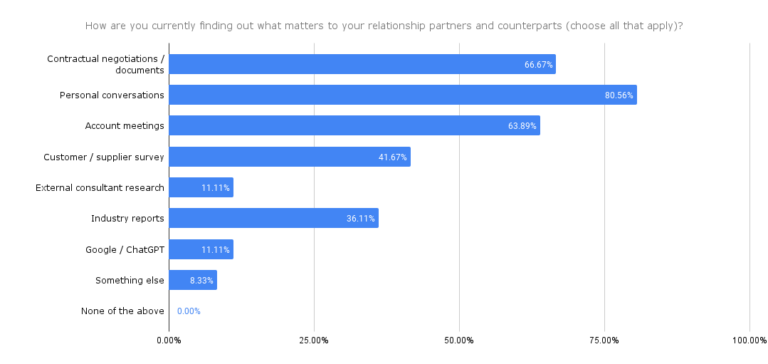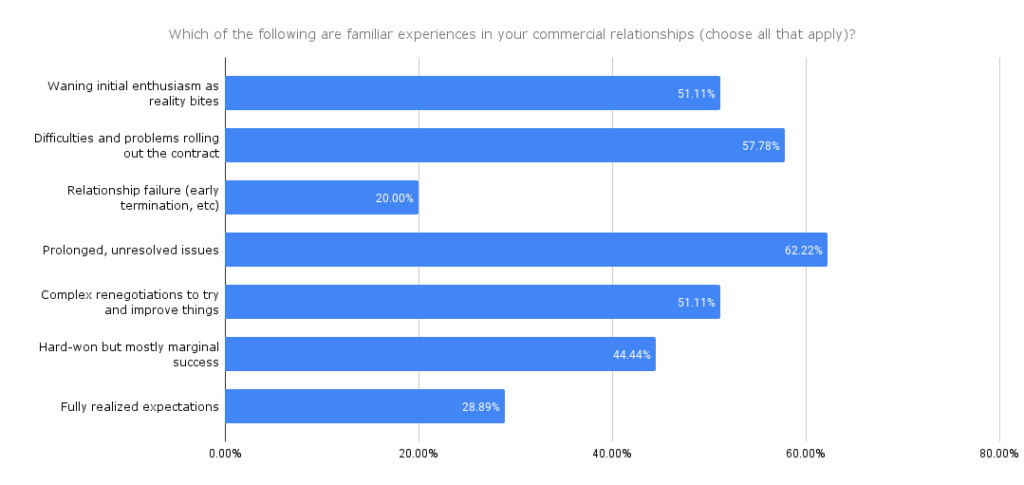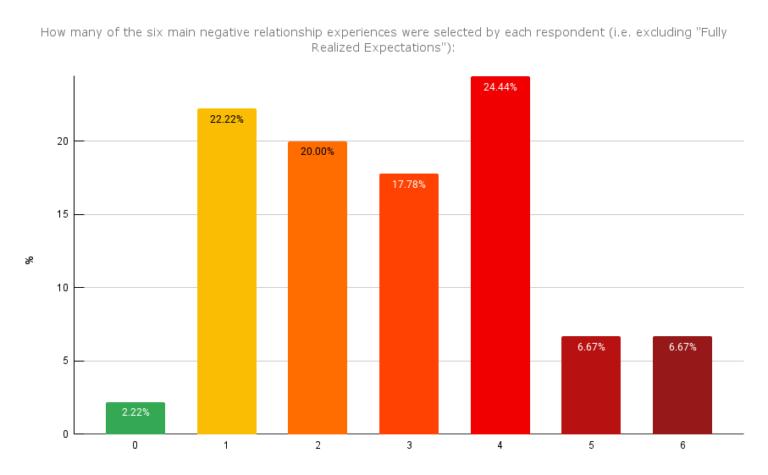Relationships: The Will May Be There… But The Way Isn’t

In our latest webinar on the Things That Matter, polls demonstrated that the will to understand partners may be there, but the way isn’t. Well-intended personal contact tries and fails to plug that gap, with negative and challenging experiences continuing to dominate relationships. This isn’t sustainable.
Last week, I had the pleasure of continuing our Things That Matter webinar series with WorldCC members:
- The first webinar introduced the concept and focused on establishing that people aren’t clear and aligned on the Things That Matter.
- This second webinar looked in more depth at the relationship issues that follow from this lack of alignment and at how the Things That Matter process is the antidote.
To illustrate both these points, I used a version of our expectations curve, which shows the typical progression of relationships through their lifecyle stages (as well as projects and initiatives in general).
I talked through how this curve describes familiar experiences and identified two inflection points that provided opportunities for changing this pattern: heading off relationship issues before they occur, or overcoming them once they’ve arisen:

I then made the case that empathy is the starting point in all cases – leading to a chain of empathy → understanding → alignment → collaboration → trust – and I set out how our Three Step Process is the way to “operationalize” empathy at the organizational level by:
- Establishing empathy through surfacing Things That Matter (to the end customer, to both parties and to each party individually).
- Encapsulating that empathy by capturing the Things That Matter and re-expressing them as Value Codes.
- Harnessing that empathy by iteratively deploying those Value Codes to agree the current state, set targets and identify the improvement actions necessary.
Along the way, there were two polls of webinar attendees, and – as with the polls in the first webinar – the findings were both striking and backed-up what we’ve been saying: relationships are struggling, and what we’re currently doing (whilst usually well-intended and often having value) can’t properly respond to these challenges.
Because what we saw was that the will might well be there at the moment, but the way isn’t.
Poll 1: The Will Is There
Right at the start of the webinar – before even revisiting the (unclear and misaligned) state of the Things That Matter – I asked attendees “How are you currently finding out what matters to your relationship partners and counterparts (choose all that apply)?“.
I wanted to get people into the headspace of thinking about how they’re engaging with their relationship partners, establish if the list of options presented covered most of what people are doing, and then set up a comparison point for later when we looked at the Things That Matter approach.
Here’s what participants said, and whilst it was encouraging in some key ways, we’ll see that it also made some latent issues clear:

So, straight away, you’ll spot that everyone seemed to relate to the notion – at least on some level – of trying to find out what matters to their partners (0% for “None of the above“), and that’s the first encouragement.
Next notice that <10% chose “Something else“: it therefore seems reasonable to assume that the options presented pretty much cover what people are currently doing. We’ll come back to that.
From there, it’s clear that direct personal contact is doing the heavy-lifting here – particularly in “Personal conversations” (80.56%), but also in “Account meetings” (63.89%) – and we stress throughout this site and in our approach that people are key, so that’s also an encouragement… at least up to a point.
Why “up to a point”, though? Three reasons:
- By definition they’re limited “touch points” with the other party – even in an account meeting, it’s almost always a small subset of those involved in the relationship that attend – so they can’t scale.
- We established last time that the Things That Matter aren’t clear and aligned, so the focus and effectiveness of those conversations will often be compromised, with personal rapport often aiming to overcome this, rather than flowing from it.
- What happens when personnel change? Continuity is typically broken and the fragility of relying on personal rapport alone is often exposed.
It’s therefore perhaps unsurprising that 2/3 of people are looking to “Contractual negotiations / documents” to try and plug these gaps… but we learned last time that only 40% feel their contracts and tenders articulate and capture what matters to their organizations.
And I said we’d come back to how these options seem to cover what people are doing… at which point notice these options are all some combination of just involving a select group, one way, from outside the relationship, and about a single point in time.
So, what we’re currently doing doesn’t involve wide engagement and being two-way and coming from inside the relationship and being ongoing.
So, the will is there…
Poll 2: The Way Isn’t There
…but the way doesn’t seem to be, and that’s what we saw confirmed with our second poll.
In our first webinar, we looked at some of the specific issues people are familiar with; here, we put a “shape” to those with the curve:
Following the progression of the curve, we then asked “Which of the following are familiar experiences in your commercial relationships (choose all that apply)?“. Initial enthusiasm was assumed – maybe not “exuberant” enthusiasm, but at least an optimistic intent and purpose – but after that point, we tracked each of the main “stages” along the curve. Again, the results were striking:

Four out of six “negative” experiences were familiar to over 50% of participants, with the most familiar one being “Prolonged, unresolved issues“.
Looking at it the other way, only 44% of people are familiar with even “Hard-won but mostly marginal success“; less than 30% were familiar with “Fully realized expectations“.
(Note, too, that these add up to 74%, which loosely tallies with our 67% for those two outcomes – it’s mostly that “Fully realized expectations” is significantly lower than we put it, and I did say in the webinar that these stats were likely conservative in presenting how challenging things are.)
Even though it tallies with our 18%, it was also hard-hitting to see that 20% of respondents were familiar with the experience of “Relationship failure“.
But that’s not all.
Because we were then able to analyze the raw data from the poll to see how many of the negative experiences each respondent was familiar with (i.e. excluding “Fully realized expectations“):

We see that – except for a tiny minority of ~2% – everyone is familiar with at least one of those experiences, and the “at least one” is important:
- 75% were familiar with 2 or more negative experiences: a large majority of people are used to dealing with at least one of them.
- >50% were familiar with 3 or more: half of people are familiar with at least half of what can go wrong.
- 1/3 are familiar with 4 or more: 1/3 of people are familiar with 2/3 or more of what can go wrong.
Now, of course, we should remember a few things at this point:
- The poll used the word “familiar”, and that will have meant different things to different people – for some, it could be “I experienced that once or twice“, whilst for others it would be “this is a constant experience“, so it’s not a precise measure.
- There may be other positive experiences that would have gained traction if we’d put them in the poll (although, to be fair, the same could be said about other negative experiences!)
- Whilst this all fully tallies with our findings elsewhere – hence we developed the curve graphic – it was a fairly swift poll of a relatively small and specific group.
However, the overall picture seems clear: relationships are struggling, and failure and struggle are more common experiences than even hard-won marginal success – much less outright success.
In Summary
Even in the space of just two quick polls, the webinar established and confirmed what we see everywhere – people seem to want to work more effectively and empathetically with their partners, but they just don’t have what they need to achieve that.
The will is there, but the way isn’t.
And so by far the more dominant experiences of working in those relationships are challenging at best – demoralizing and depressing at worst – with huge waste and cost all round, in both financial and human terms.
This isn’t sustainable.
But, as we went on to see in the webinar, the way is now there to complement the will to do better: our Three Step Process for establishing, encapsulating and harnessing empathy.
This provides that missing combination I talked about earlier of wide engagement and being two-way and coming from inside the relationship and being ongoing.
Are you ready to start turning things round – overcoming the issues you’re currently facing in relationships, and beginning to head them off before they even arise?

